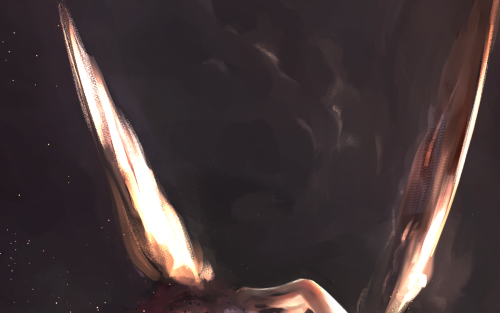
20. she/her - bisexual / nct&exo / markhyuck enthusiast / @badlem_ on twitter
211 posts
Latest Posts by badlems - Page 3



McGonagall, done with Dumbledore’s shit.



Bohemian Rhapsody
- Queen, Rock Montreal [1981]









🎼 Agnetha Fältskog & Anni-Frid (Frida) Lyngstad of ABBA 🇸🇪






Leonardo DiCaprio in ROMEO & JULIET (1996) dir. Baz Luhrmann









Cyberpunk scenarios in Borderlands 3








Art by @/ninjajo_art ( Katerina Belikova ) on Instagram

Our water-seeking robotic Moon rover just booked a ride to the Moon’s South Pole. Astrobotic of Pittsburgh, Pennsylvania, has been selected to deliver the Volatiles Investigating Polar Exploration Rover, or VIPER, to the Moon in 2023. During its 100-Earth-day mission, the approximately 1,000-pound rover will roam several miles and use its four science instruments to sample various soil environments in search of water ice. Its survey will help pave the way for a new era of human missions to the lunar surface and will bring us a step closer to developing a sustainable, long-term robotic and human presence on the Moon as part of the Artemis program.
Make sure to follow us on Tumblr for your regular dose of space: http://nasa.tumblr.com

Curious about NASA’s next mission to the Red Planet – the Mars 2020 Perseverance rover? Here’s your chance to ask an expert!
Targeted for launch to the Red Planet in July 2020, our Mars 2020 Perseverance rover will search for signs of ancient life. Mission engineer Lauren DuCharme and astrobiologist Sarah Stewart Johnson will be taking your questions in an Answer Time session on Friday, July 17 from noon to 1pm ET here on our Tumblr! Make sure to ask your question now by visiting http://nasa.tumblr.com/ask
Lauren DuCharme is a systems engineer at NASA’s Jet Propulsion Laboratory (JPL) in Southern California, where she’s working on the launch and cruise of the Perseverance rover. Lauren got her start at JPL as an intern. Professor Sarah Stewart Johnson is an astrobiologist at Georgetown University in Washington. Her research focuses on detecting biosignatures, or traces of life, in planetary environments.
Fun Facts:
The name Perseverance was chosen from among the 28,000 essays submitted during the “Name the Rover” contest. Seventh-grader Alex Mather wrote in his winning essay, “We are a species of explorers, and we will meet many setbacks on the way to Mars. However, we can persevere. We, not as a nation but as humans, will not give up.”
Perseverance will land in Jezero Crater, a 28-mile-wide (45-kilometer-wide) crater that scientists believe was once filled with water.
Perseverance carries instruments and technology that will pave the way for future human missions to the Moon and Mars. It is also carrying 23 cameras and two microphones to the Red Planet — the most ever flown in the history of deep-space exploration.
Perseverance is the first leg of a round trip to Mars. It will be the first rover to bring a sample caching system to Mars that will package promising samples for return to Earth by a future mission.
Make sure to follow us on Tumblr for your regular dose of space: http://nasa.tumblr.com.
Was There Once Life On Mars? Our Perseverance Rover Aims to Find Out
Our Perseverance mission is set to launch on Thursday, July 30 and could help answer many longstanding astrobiology questions about Mars. The mission will deliver our Perseverance rover to the Martian surface, and this powerful rover is equipped with a multitude of tools to study the planet’s environment and to answer questions about whether or not the Red Planet could have had life in the past.

In preparation for launch, our Astrobiology Program is releasing a new update to Issue #2 of the graphic history series, Astrobiology: The Story of our Search for Life in the Universe. This new, fourth edition tells the tale of our exploration of Mars in relation to astrobiology.

The history of our exploration of Mars is full of struggle and triumph. Mars is a dangerous and difficult planet to visit, with frigid temperatures, damaging dust storms, low gravity, and a thin atmosphere. Despite the challenges, NASA missions have opened our eyes to a world that was much more Earth-like in its past, with environments that contained all the necessary conditions for life as we know it.

Issue #2 tells the complete history of our endeavours on Mars, from the Mariner missions to Viking and Pathfinder to Curiosity. In this fourth edition, you’ll find details on the Perseverance rover and its journey to search for ancient signs and signatures of life that could once and for all tell us whether or not life gained a foothold on the ancient Red Planet.

Perseverance will also drill into Martian rocks and collect samples that will one day be returned to Earth by a future Mars Sample Return mission. The samples will be stored in special containers and carefully ‘cached’ in a location on Mars where they will be easily accessible for retrieval. These samples will allow astrobiologists to perform detailed experiments that robots are not yet able to undertake remotely.

Visit astrobiology.nasa.gov/graphic-histories/ to download the new edition of Astrobiology: The Story of our Search for Life in the Universe, and read the entire series to explore NASA’s astrobiology journey to understand the origin and evolution of life on Earth, and the potential for life elsewhere in the Universe!
Make sure to follow us on Tumblr for your regular dose of space: http://nasa.tumblr.com
7 Things to Know about the Perseverance Mars Rover

We’re set to launch the Mars 2020 Perseverance rover mission from Cape Canaveral, Florida, on July 30. The rover is loaded with scientific instruments and advanced technology, making it the largest, heaviest and most sophisticated vehicle ever sent to the Red Planet.
What is Perseverance’s mission and what will it do on Mars? Here are seven things to know:
1. Perseverance draws on the NASA – and scientific – spirit of overcoming challenges

Not only does it have to launch during a pandemic and land on a treacherous planet, it has to carry out its science goals:
Searching for signs of past microbial life
Mapping out the planet’s geology and climate
Collecting rock and other samples for future return to Earth
Paving the way for human exploration
We chose the name Perseverance from among the 28,000 essays submitted during the “Name the Rover” contest. Because of the coronavirus pandemic, the months leading up to the launch in particular have required creative problem solving, teamwork and determination.
2. Perseverance builds on the lessons from other Mars rovers

In 1997, our first Mars rover – Sojourner – showed that a robot could rove on the Red Planet. Spirit and Opportunity, which both landed in 2004, found evidence that Mars once had water before becoming a frozen desert.
Curiosity found evidence that Mars’ Gale Crater was home to a lake billions of years ago and that there was an environment that may have sustained microbial life. Perseverance aims to answer the age-old question – are there any signs that life once existed on Mars?
3. Perseverance will land in a place with high potential to find signs of ancient life

The rover will land in Jezero Crater, a 28-mile wide basin north of the Martian equator. A space rock hit the surface long ago, creating the large hole. Between 3 and 4 billion years ago, a river flowed into a body of water in Jezero the size of Lake Tahoe.
4. Perseverance will also collect important data about Mars’ geology and climate

Mars orbiters have collected images and other data about Jezero Crater from about 200 miles above, but finding signs of past life will need much closer inspection. A rover like Perseverance can look for those signs that may be related to ancient life and analyze the context in which they were found to see if the origins were biological.
5. Perseverance is the first leg of a round trip to Mars

This is the first rover to bring a sample-gathering system to Mars that will package promising samples of rocks and other materials for future return to Earth. NASA and ESA are working on the Mars Sample Return campaign, so we can analyze the rocks and sediment with tools too large and complex to send to space.
6. Perseverance will pave the way for human exploration of the Red Planet

Two packages – one that helps the rover autonomously avoid hazards during landing (TRN) and another that gathers crucial data during the trip through Mars’ atmosphere (MEDLI2) – will help future human missions land safely and with larger payloads on other worlds.
There are two instruments that will specifically help astronauts on the Red Planet. One (MEDA) will provide key information about the planet’s weather, climate and dust activity, while a technology demonstration (MOXIE) aims to extract oxygen from Mars’ mostly carbon-dioxide atmosphere.
7. You get to ride along

Perseverance and other parts of the Mars 2020 spacecraft feature 23 cameras, which is more than any other interplanetary mission in history. Raw images from the camera are set to be released on the mission website.
There are also three silicon chips with the names of nearly 11 million people who signed up to send their names to Mars.
And you can continue to follow the mission on Twitter and Facebook.
Make sure to follow us on Tumblr for your regular dose of space: http://nasa.tumblr.com









xiaojun + take over the moon era for anon ♡








Blade Runner (1982), dir. Ridley Scott
Making the Skies Safe for Unmanned Aircraft
Unmanned Aircraft Systems (commonly known as UAS or drones) are typically a smaller aircraft that fly without an onboard pilot. Currently used for research, testing, and aerial-visual purposes, these vehicles could one day carry cargo, or even passengers, through countryside and city landscapes.

UAS are a key component of our Unmanned Aircraft Systems Integration in the National Aairspace Ssystem (UAS in the NAS) project. Our research will help develop the rules so that unmanned aircraft can safely coexist with manned aircraft in the national airspace.

We collaborate with private companies, like Navmar Applied Science Corporation (NASC), to research and test aerodynamically efficient UAS. We also work with government agencies like the Federal Aviation Administration (FAA) to conduct research that will contribute to setting standards and certifications.

We are leading the nation to open a new era in air transportation called Advanced Air Mobility (AAM). AAM will enable safe, sustainable, affordable, and accessible aviation that moves people and cargo between places using a transformed air transportation system and revolutionary new aircraft.

With new cost-and-fuel efficient aircraft and technologies becoming available, UAS will provide substantial benefit to U.S. industry and the public. Such benefits include air-lifted organ transplant deliveries that arrive more quickly and safely than ever before; and search and rescue missions performed with increased speed and accuracy.

There are other benefits too, like pizza being air- dropped to your front door, and less package delivery trucks on the road. The burgeoning landscape of AAM holds many potentials – and it’s our job to help safely and sustainably map out and navigate what that future landscape looks like.
Want to learn the many ways that NASA is with you when you fly? Visit https://www.nasa.gov/aeronautics. Make sure to follow us on Tumblr for your regular dose of space: http://nasa.tumblr.com.










Art by Sergii Golotovskiy on Artstation.
Music: Stromae - Alors On Danse (Clip Officiel)





Pacific Rim (2013) - Guillermo del Toro
Another favorite movie set in Hong Kong!











Virtual Biologics Reprogrammig Lab… but where are the scientists?

Biochemical Ghost




Space engineering labo 🌐💫




Inertia.
The As, Gs, Cs and Ts of the Space Station: First In-Space Microbe Identification
Being able to identify microbes in real-time aboard the International Space Station, without having to send them back to Earth for identification first, would be totally amazing for the world of microbiology and space exploration.

The Genes in Space 3 team turned that possibility into a reality this year, when it completed the first-ever sample-to-sequence process entirely aboard the space station.
The ability to identify microbes in space could aid in the ability to diagnose and treat astronauts in real time, as well as assisting in the identification of life on other planets. It could also benefit other experiments aboard the space station.
HELPFUL SCIENCE HINT: Identifying microbes involves isolating the DNA of samples, and then amplifying – or making lots and lots (and LOTS) of copies - of that DNA that can then be sequenced, or identified.
As part of regular monitoring, petri plates were touched to various surfaces of the space station. NASA astronaut Peggy Whitson transferred cells from growing bacterial colonies on those plates into miniature test tubes, something that had never been done before in space (first OMG moment!).

Once the cells were successfully collected, it was time to isolate the DNA and prepare it for sequencing, enabling the identification of the unknown organisms – another first for space microbiology.
Enter Hurricane Harvey. *thunder booms*

“We started hearing the reports of Hurricane Harvey the week in between Peggy performing the first part of collecting the sample and gearing up for the actual sequencing,” said Sarah Wallace, the project’s primary investigator.
When our Johnson Space Center (JSC) in Houston became inaccessible due hurricane conditions, Marshall Space Flight Center’s Payload Operations Integration Center in Huntsville, Alabama worked to connect Wallace to Whitson using Wallace’s personal cell phone.
With a hurricane wreaking havoc outside, Wallace and Whitson set out to make history.

The data were downlinked to the team in Houston for analysis and identification.
“Once we actually got the data on the ground we were able to turn it around and start analyzing it,” said Aaron Burton, the project’s co-investigator. “You get all these squiggle plots and you have to turn that into As, Gs, Cs and Ts.”
Those As, Gs, Cs and Ts are more than just a nerdy alphabet – they are Adenine, Guanine, Cytosine and Thymine – the four bases that make up each strand of DNA and can tell you what organism the strand of DNA came from.

“Right away, we saw one microorganism pop up, and then a second one, and they were things that we find all the time on the space station,” said Wallace. “The validation of these results would be when we got the sample back to test on Earth.”
Soon after, the samples returned to Earth aboard the Soyuz spacecraft, along with Whitson.
With the samples now in the team’s JSC lab, tests were completed in ground labs to confirm the findings from the space station. They ran the tests again and again, and then once more, to confirm accuracy. Each time, the results were exactly the same on the ground as in orbit. (second OMG moment!)

“We did it. Everything worked perfectly,” said Sarah Stahl, microbiologist.
This capability could change future space exploration.
“As a microbiologist,” said Wallace, “My goal is really so that when we go and we move beyond ISS and we’re headed towards Mars or the moon or wherever we are headed to, we have a process that the crew can have that great understanding of the environment, based on molecular technology.”
For more information, follow @ISS_Research.
Make sure to follow us on Tumblr for your regular dose of space: http://nasa.tumblr.com.

By Cabvno
https://www.youtube.com/channel/UCd3QP6P3YdLXSX29z8kzhPw
How does a microgravity garden grow when there’s no up or down? An advanced chamber, about the size of a mini-fridge, is giving us a clearer perspective of plant growth habits. Without gravity and the addition of a wide variety of light and humidity settings, the plants cultivated on the International Space Station provide a world of opportunity to study space-based agricultural cycles.
Learn more about our space garden HERE.
Make sure to follow us on Tumblr for your regular dose of space: http://nasa.tumblr.com






our orbit was the first embrace
// study of Psyche Revived by Cupid’s Kiss



our orbit was the first embrace
// study of Psyche Revived by Cupid’s Kiss




vernon trauma at gayo daechukje 2019










OT13 ˚ * ❀ 舞い落ちる花びら (Fallin’ Flower)








vernon’s pretty eyelashes